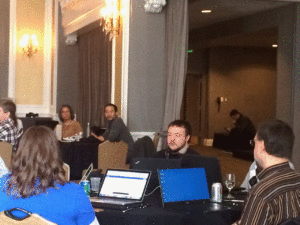There are lots of ways that companies seek input from their customers, but it’s not every day you get an invitation to help build a product you use—to help shape it with your ideas, your needs, your words, and even your hands.
Salesforce.org does exactly that. Through a series of Community Sprints held around the country, they have an open invitation for customers and partners to gather to share feedback, write code and improve documentation for the core Salesforce-based toolkit—the Nonprofit Success Pack (NPSP)—used in tens of thousands of nonprofit organizations.
Most recently, a group of more than 80 participants met on March 21st and 22nd, 2017, at the NPSP Community Sprint in Baltimore. Participants came from across the nonprofit landscape, with varying missions, size and experience with Salesforce, along with a broad array of freelancers, consulting partners, integration vendors and, of course, dedicated and inspiring Salesforce.org employees that build and manage NPSP day-to-day.
 Thoughtful conversation on address management considerations with a large migration.
Thoughtful conversation on address management considerations with a large migration.This event is part of an ongoing strategy that sets NPSP apart from similar nonprofit fundraising products. It creates an opportunity not only for product feedback and new features, but for collaborative problem solving, and for the creativity that comes from bringing to the table a group of folks with diverse perspectives, needs and skill sets. There were many occasions over the two days when developers approached a problem, excited to write code and add functionality, only to find that when they engaged in dialog with admins, SF.org staff and users, all that was needed was better guidance via improved documentation!
A Flexible, Enterprise Ready Foundation
This approach to development has led NPSP through a steady, paced, organic evolution over the years, an evolution that ACF has followed closely. For years, our team has known that NPSP is a good fit for smaller, budget conscious organizations that need householding and donor management features. But, as I reflect upon this most recent sprint and our recent projects with NPSP, like our work with International Justice Mission and our upcoming projects with the Boston Athletic Association, and the National Audubon Society, it is becoming increasingly clear that NPSP also provides a solid foundation for large, enterprise-scale nonprofits. (You also can read our blog post on this topic.)
When considering NPSP on an enterprise scale, it’s important to understand its role and its promise in the context of the broader Salesforce AppExchange ecosystem. Nonprofits are incredibly diverse. Any product that makes too many assumptions about who your constituents are, how they will interact with you, or how you will serve them ultimately will produce problems, in particular at an enterprise scale. NPSP establishes a scalable, core foundation for your organization, providing key features for contacts, householding, addresses, donor prospecting, engagement tracking and management and other capabilities that most nonprofits need. Beyond that, NPSP gets out of the way, allowing you to select from the breadth of the Salesforce AppExchange ecosystem to meet your needs for events management, mass emails, and other common enterprise requirements.
Where from here?
Salesforce.org has made a clear and substantial commitment to NPSP, and they have proven to be astute at listening and learning from their community of customers and partners. I encourage all of our clients using NPSP to find a way to participate in a sprint. Look out for the next NPSP Community Sprint in Chicago August 8th and 9th. In the meantime, join in the community conversation with 15,000 other NPSPers on the Power of Us Hub.










